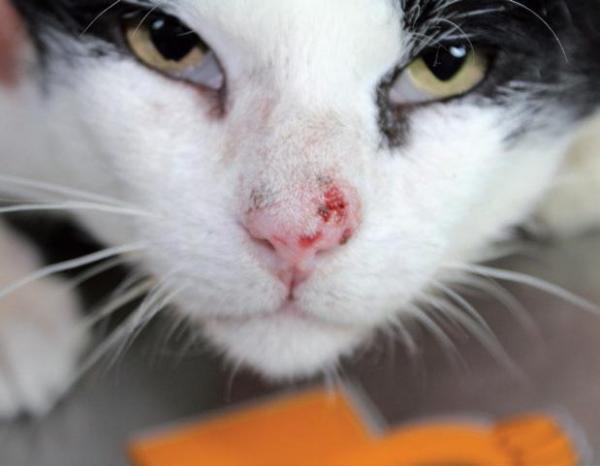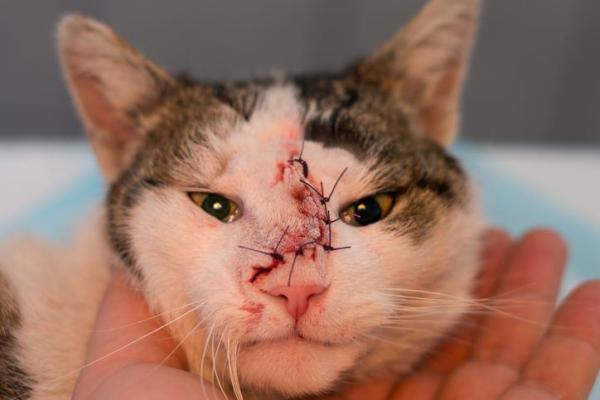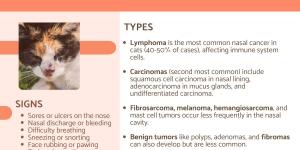Cat Skin Cancer - Symptoms and Treatment



See files for Cats
It is common for caregivers to panic when they detect a lump on any part of a cat's body. Some ignore it for fear that it is some kind of skin cancer, but the truth is that not all lumps are synonymous with cancer. In any case, lumps can be curable so the soonest possible detection and treatment is essential.
In this AnimalWised article, we discuss cat skin cancer and explain why we should go to the veterinarian if we notice any skin alteration. To do so, we need to know more about the symptoms and treatment of feline skin cancer.
Types of skin tumors found in cats
The detection of lumps in cats is a cause for concern for any guardian. Not all the masses that we may find are going to be tumors, abscesses or swollen lymph nodes are also common. Swollen lymph nodes are a common reason why we may find a lump on a cat's neck.
Regardless of the likelihood, every lump should be examined by a veterinarian in order to obtain a diagnosis. By studying the cells present in the lump we can determine if it is malignant. This cytological examination also gives us information on whether any skin cancer in the cat is benign or malignant. These cells can be removed by fine needle aspiration, or the lump can be removed and a sample sent to the laboratory.
White cats and any cats over eight years of age are most likely to develop skin cancer. For example, carcinoma on the nose or ears is more common in white cats. Known as squamous cell carcinoma, this is the most common type of skin cancer in cats and is related to the cat being exposed to sunlight.
Similarly, skin tumors in cats are not the only type that can appear. They can also suffer from other types of cancer such as lymphoma or mammary carcinoma. For more information on this subject, take a look at the reason why your cat's lymphocytes are high.
Symptoms of skin cancer in cats
Lesions on the cat’s body should alert us to the possibility of cancer. We can feel or observe masses that grow with greater or lesser speed. Some are very distinct, while others do not have well-defined limits. They can ulcerate and we will see wounds on the surface of the skin. These may bleed and sometimes give off a bad odor. Sometimes the nearest lymph nodes are also swollen.
On the other hand, cutaneous neoplasms do not always present as lumps, but appear as itching or redness, scales and scabs. In the case with scabs on a cat's skin, some will present as brown spots. Finally, warts in cats usually correspond to benign tumors, although we should always go to the veterinarian for evaluation.
If you observe any of these symptoms of skin cancer in cats, do not hesitate to go to your chosen veterinary clinic as soon as possible to perform the tests mentioned above.

How to detect skin cancer in cats
Before starting treatment, it is essential to get a diagnosis that tells us what type of skin cancer we are dealing with. In addition to cytology or biopsy, the veterinarian can perform blood tests, radiography or an ultrasound. These tests give information about the general condition of the cat and allow us to know if there is metastasis or not. This refers to whether the cancer has spread to other parts of the body or if it is localized.
The treatment, the prognosis and the possibility of recurrence, i.e. that the cancer will reappear, all depend on this information.
Treatment of cat skin cancer
Depending on the type, some forms of cancer can be cured by surgical removal, but the cat will still need to have regular veterinary check-ups in case of recurrence. Chemotherapy is the treatment of choice in other cases. So-called anti-angiogenic treatments may also be considered, consisting of preventing the tumor from developing new blood vessels, thus reducing the supply of nutrients and, consequently, its progression.
Several treatments can be combined to cure skin cancer in cats. In any case, the prognosis is always considered with caution. At this point, we should keep in mind that the main thing for our cat is its quality of life, rather than the length of their life.

Is skin cancer in cats contagious?
Cancer is a process that develops due to multiple individual factors. Cells reproduce continuously throughout a cat's life, but what happens with cancer is that there is a particular out-of-control cellular growth which causes masses to form and displace normal cells. Therefore, the development of cancer cannot be transmitted to other animals or people.

This article is purely informative. AnimalWised does not have the authority to prescribe any veterinary treatment or create a diagnosis. We invite you to take your pet to the veterinarian if they are suffering from any condition or pain.
If you want to read similar articles to Cat Skin Cancer - Symptoms and Treatment, we recommend you visit our Skin problems category.
- Machicote, G. (2017). Skin tumors. Ateuves Magazine, 67, 20-24.







